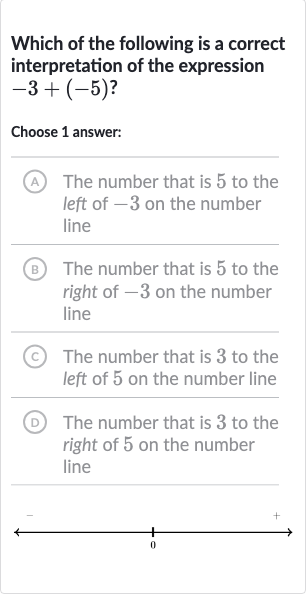AI tutor
Welcome to Bytelearn!
Let’s check out your problem:

Which of the following is a correct interpretation of the expression Choose answer:(A) The number that is to the left of on the number line(B) The number that is to the right of on the number line(C) The number that is to the left of on the number line(D) The number that is to the right of on the number line
Full solution
Q. Which of the following is a correct interpretation of the expression Choose answer:(A) The number that is to the left of on the number line(B) The number that is to the right of on the number line(C) The number that is to the left of on the number line(D) The number that is to the right of on the number line
- Understand the expression: Understand the expression . This expression means starting at on the number line and moving units to the left, because adding a negative number is equivalent to moving left on the number line.
- Perform the calculation: Perform the calculation . Starting at and moving units to the left gives us .
- Match the result: Match the result of the calculation with the correct interpretation. The calculation shows that the number is units to the left of on the number line, which corresponds to option (A).
- Verify other options: Verify that none of the other options match the calculation. Option (B) suggests moving to the right, which is incorrect. Option (C) and (D) involve the number , which is not the starting point of our expression, so they are also incorrect.
More problems from Quantities that combine to zero: word problems
QuestionGet tutor help
QuestionGet tutor help
QuestionGet tutor help
QuestionGet tutor help
QuestionGet tutor help
QuestionGet tutor help
QuestionGet tutor help
QuestionGet tutor help
QuestionGet tutor help
